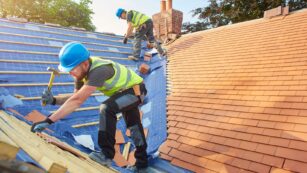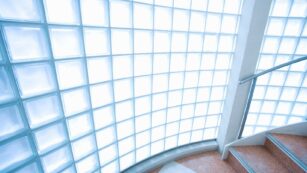In this article, we will discuss the differences between a flat roof and a pitched roof, the pros and cons of a pitched roof, and the different types of pitched roofs you can choose from.
Current discussion on pitched and flat roofs
Originally, all the roofs in the area where it rained or snowed regularly were sloping. Even the huts on the base were tilted to prevent rain or snow from falling. Buildings in the desert, where there was no need to worry about rain and snow accumulating on their roofs, were an exception. You can still see that difference today. In Europe, the United States and Asia, where it rains a lot, most roofs are mowed down. In the Middle East you see a lot of flat roofs.
Then, in the mid-19th century. At the end of the 19th century, Europeans began to build flat roofs, which were covered with tar. The roof still had a slight slope to the sewer, but overall the flat design was much more favorable. It is possible to construct a tall building without additional rafters or other structural supports for a high, pitched roof. In addition, the roof area was smaller, saving on roof finishing materials.
Of course, the flat roof was not as elegant, so it was more often used for functional buildings and low budget houses. In New York City, many buildings with flat roofs were built during this period. Storefronts, factories, apartment buildings and affordable housing are all characterized by flat roofs. An advantage for the residents was that the flat roof gave access to the terrace to enjoy the view of the city, a place to hang laundry or grow plants, and a place to build water towers in the city. In addition, flat roofs were a smart concept for urban living because they keep snow and rain from falling on the pavement.
The flat roof has become such a symbol of life in the big cities that other parts of the country have started to disguise sloping roofs as flat roofs! Instead of saving, they spend the money to build false facades on their houses and buildings.
Pitched roofs came back into fashion when asphalt shingles were invented and it became cheaper to cover a roof with shingles than the shingles and tiles used to cover pitched roofs. Asphalt shingles are still the cheapest way to cover a pitched roof, but there are many other materials to choose from.
Nowadays, flat roofs are usually used in businesses, office buildings and large residential buildings to stay high and save on construction costs in big cities, while single-family homes are usually built with some kind of pitched roof.
Advantages and disadvantages of flat and pitched roofs
How do flat roofs relate to pitched roofs in modern architecture?
Roofing materials
Nowadays, most flat roofs are made of rubber. It is very durable and waterproof. It is also very easy to repair if you have problems with your roof.
Pitched roofs are constructed of several layers, including plywood, underlayment and other surface materials : Shingles, shingles, metal panels, etc. All of these materials are very durable, with proper installation and maintenance.
End result:Flat and pitched roofing materials are strong and durable enough to be used in rainy or snowy climates.
Roof shape Wind resistance
Besides rainfall, wind is the biggest threat to your roof. Sloping roofs are aerodynamically designed so that the wind rolls up and overcomes the slope of the roof. However, this is somewhat dependent on the wind direction and slope. The wind can always take over the slope of the roof from below. In addition to the shape, you also have access to a wind-sensitive end material. It is very easy to buckle the shingles, especially in high winds.
A flat roof is aerodynamic because it has no profile. The wind is blowing across the roof.
Conclusion:Flat roofs are less sensitive to wind loads.
Roof maintenance
No roof lasts forever, even if the metal is booming. A metal roof can last 50 to 100 years, depending on the type of metal used. However, every roof needs maintenance to last. Flat roofs, like pitched roofs, should be cleaned regularly to maintain their appearance and prevent surface materials from reacting with dirt and breaking down. If you have a pitched roof, you will also need to replace broken shingles or re-coat them to protect them. With the exception of metal roofs, pitched roofs can last up to 30 years without replacement.
A flat roof, on the other hand, needs to be completely renewed every ten years. In the meantime, you should also repair the roof if it has any weak points.
Conclusion:Neither a pitched nor a flat roof is difficult or time consuming to maintain, but a pitched roof lasts longer than a flat roof.
Costs of construction or replacement of roof
Sloped roofs can be built or replaced relatively inexpensively, depending on the type of slope and the material chosen. The simplest roof models, with asphalt shingles, are the most economical. More complex roof structures with a copper roof would be the most expensive. Part of the higher construction cost of a pitched roof is simply the extra material required to reach the top of the roof and then slope it down the length of the building.
The house remains cheaper to build and replace because you are not adding materials for the siding. As we all know, the shortest distance between two points is a straight line, and a flat roof draws a straight line through a building. In addition, rubber shingles for flat roofs are still less expensive than asphalt shingles, not to mention the more expensive materials that can be used for pitched roofs.
Conclusion:Flat roofs are cheaper to build and replace than pitched roofs.
Space limitations
A pitched roof works well if you have enough room on both sides of the structure to allow the roof to extend over the building. It’s also not a problem if your building is low enough not to exceed height restrictions in your neighborhood.
Flat roofs are perfect for holding buildings together because you don’t need an extra overhang. In some cases, you can even increase the size of the building because you don’t have to leave room for an overhanging roof. You can also build up to the ultimate height with usable space. This is especially important in cities where you may want to build the tallest office or apartment building to maximize your rental income.
Conclusion:Flat roofs are best suited to fit well and maximise space.
Visual appeal
But here’s the real advantage of pitched roofs, and it’s the deciding factor for most homeowners. In fact, they won’t even consider a flat roof because it doesn’t look like the kind of roof that should be installed on the house.
A pitched roof gives your home extra appeal with an interesting architectural design. Even if it is a simple gable roof, it always occupies a more interesting place in the house than a gable roof. An added benefit of pitched roofs in general is that there are many styles you can choose from to get exactly the look you want. In addition, you can determine the appearance of the roof by choosing the material and color of the deck : Asphalt shingles, shingles, metal sheets, metal shingles, glass, etc.
A flat roof doesn’t necessarily look bad, it just looks smooth. There is no flat roof character and practically no attitude. You get a flat roof covered with a simple material.
Conclusion:Pitched roofs are more visually appealing and allow for a greater variety of building styles and visual aesthetics than flat roofs.
Should I choose a pitched roof or a flat roof?
As we have seen, the flat roof style has many advantages. It is as durable and watertight as a pitched roof. It is even more wind resistant than a pitched roof. It is easy to maintain and more economical to produce and replace. This maximizes space both vertically and horizontally.
But a flat roof cannot have the appearance of a sloped roof. Moreover, a flat roof needs to be re-covered more regularly than a pitched roof.
Most people will agree that if you are building a commercial building or a multi-family home where cost savings or maximizing living space is your primary requirement, you can’t beat the cost-effectiveness of a flat roof. However, if you are building a house or other structure that you want to make visually appealing, opt for a pitched roof.
Post Views :
5
frequently asked questions
What is the flattest or steepest roof?
The lifespan of a pitched roof is generally higher than that of a flat roof, which is why many homeowners choose it because of its features. The materials used are usually more weather-resistant and durable, although this gap is beginning to be filled with the emergence of more durable materials in the flat roof market.
Is it cheaper to build a flat or pitched roof?
Compared to a sloped roof installation, flat roofs are generally cheaper, mainly because flat roof materials often play a bigger role in small panels than sloped roof materials. The roofing system also requires less wood.
Are flat roofs better?
Many homeowners are increasingly attracted to flat roofs because they are considered one of the most energy-efficient options, according to Energy Star. In addition, consumers can save money on the initial installation of the roof because the area of a flat roof is smaller than that of a sloped roof.
Related Tags:
flat roof vs sloped roof kerala,flat roof vs pitched roof australia,flat roof vs pitched roof kenya,why are flat roofs good,flat roof conversion cost,difference between flat roof and pitched roof,Feedback,can a flat roof be pitched,skillion roof in nigeria,flat roof house,types of roof,sloped flat roof,standard roof slope in india,how good are flat roofs,pros and cons of pitched roof,asphalt flat roof lifespan,lifespan of felt roof,flat roof to pitched roof cost uk,flat roof with pitched sides,pitched roof extension,pitched roof vs gable roof,single pitched roof,pitched ceiling,lean to roof,shed roof,pitch roof vs flat roof,ways of giving a fall to a timber flat roof,Privacy settings,How Search works,Flat roof,Mansard roof,Butterfly roof,Saltbox house,See more,Hip roof,Asphalt shingle,Saw‑tooth roof,pitched roof v flat roof costs,why are flat roofs so expensive,flat roof vs pitched roof insulation,pitched roof vs sloped roof














